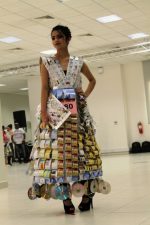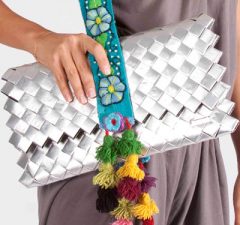 Yoav Avinoam’s sawdust benches and stools are made from the remains from someone else’s… well… benches and stools.
Yoav Avinoam’s sawdust benches and stools are made from the remains from someone else’s… well… benches and stools.
The crunchy granola types out there may think of composting toilets right away when they hear the word ‘sawdust’, but not those eco-chic greenies out there. Sawdust, a highly available yet often discarded material, is full of possibilities for the designer with the right environmentally conscious approach.
It’s malleability makes it suitable for a variety of uses and we recently learned about Israeli designer Yoav Avinoam’s Shavings furniture collection made out of sawdust. In Avinoam’s creative hands, sawdust is combined with resin and placed in molds in order to create shapes that he then uses to make furniture.
 In explaining why he uses sawdust, Avinoam says on his website that, “By using sawdust waste from the wood industry, as a response to the way we look at our usage and exploitation of material in modern culture.
In explaining why he uses sawdust, Avinoam says on his website that, “By using sawdust waste from the wood industry, as a response to the way we look at our usage and exploitation of material in modern culture.
The sawdust (taken from different kinds of woods) is being pressed with resin (plastics?) into a mold that already contains all of the object parts, the opportunity was exploring new ways of integration between the legs of the furniture and the sawdust through expansion of the joints, this and the way the sawdust crumbles towards the edges creates a new material aesthetics to once destined to be waste material.”
 Avinoam not only sees his use of the sawdust as a way to rescue a material destined for the trash, but as a means of creating a new design aesthetic. We take issue with the plastic resin though as a means of glueing all that waste together. Remember the cardboard bike? Same deal. If you put enough glue into something you will get form, even using cheap Chinese noodles.
Avinoam not only sees his use of the sawdust as a way to rescue a material destined for the trash, but as a means of creating a new design aesthetic. We take issue with the plastic resin though as a means of glueing all that waste together. Remember the cardboard bike? Same deal. If you put enough glue into something you will get form, even using cheap Chinese noodles.
Cardboard Bike from Israel Makes Cycling Even Greener
The Shavings collection was originally created as Avinoam’s graduation project from the Bezalel Academy of Art and Design in Jerusalem. The collection then continued to win “The Intelligent Hand” Massimo Marini design award in 2010. We think the design is pretty intelligent, too.
The truth is, you can make furniture out of almost any dry material, even Ramen noodles, as long as you put enough glue or resin or epoxy in the mix. So it ends up not being so much a healthy eco product but a stool, bench or table – or cardboard bike! made from glue.
I prefer the real stuff. Real wood, no fillers! No glue. No epoxies. No plastics. Whether it is a relaxing sofa set or dining table, thinking and caring about your furniture will broaden its life expectancy and keep its texture and working at its best. Buying real wood can expand your furniture’s life expectancy and it’s simple.
Or keep being inspired by more of the same above. Yoav Avinoam’s new website (2019 updated) can be found here.
Read more about sustainable furniture designers:
Studio Mesila is Paving the Track to Sustainable Design
Interview with Miklum Studio, Designers of Furniture Out of Nothing
Krooom Makes Recycled and Recyclable Cardboard Furniture for Kids of All Ages



Sounds nice, but what about the resin? Is that just another name for plastic?
Yeah. I am thinking about all these “eco” products. A cardboard bike. Bamboo plates. Have you heard of the ramen guy who fixes everything with ramen noodles? It’s basically showing us that the raw material doesn’t matter as long as it’s dry and light. Add enough glue (epoxy, resin) and well you got something. But is it eco? Not really. Give me a real wooden bench any day. I will leave the shavings for my soil.